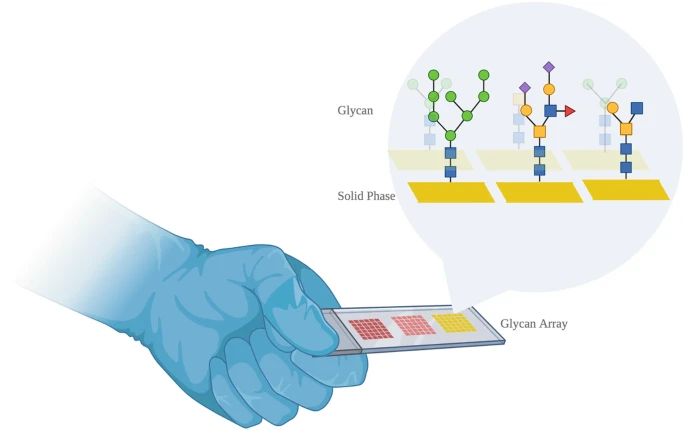Pathogen-Associated Glycan Microarray Service
- Investigation of Pathogen Recognition Mechanisms
- Vaccine and Anti-Infective Drug Development
- Strain Virulence Typing and Comparative Analysis
- Pathogen Monitoring in Environmental and Food Samples
Pathogen-Associated Glycan Microarray Service is a research service based on glycan microarray technology, designed to systematically detect and analyze the binding characteristics between pathogens (or their glycan-binding proteins, GBPs) and a wide range of structurally defined glycans. By constructing diverse glycan arrays and integrating high-sensitivity fluorescence scanning with advanced data analysis platforms, this service enables high-throughput and quantitative profiling of glycan recognition patterns by pathogens, supporting the elucidation of disease mechanisms, development of targeted intervention strategies, and advancement of glycobiology research.
Glycans play a critical role in host-pathogen interactions. Many bacteria, viruses, and toxins achieve adhesion, invasion, or immune evasion by recognizing specific glycan structures on host cell surfaces. The pathogen-associated glycan microarray serves as a high-throughput platform for systematically investigating the binding specificity between pathogens or their GBPs and various glycan structures. This technology not only helps reveal mechanisms of pathogenic infection but also provides a powerful tool for vaccine development, anti-infective drug screening, and glycosylation biomarker discovery.
MtoZ Biolabs offers Pathogen-Associated Glycan Microarray Service to systematically evaluate the binding profiles between pathogens or their glycan-binding proteins and different glycans. This supports in-depth investigation of host-pathogen interaction mechanisms and facilitates the discovery of potential glycosylation biomarkers and targets for therapeutic intervention. The service is broadly applicable to research in virology, microbiology, glycobiology, immunology, and vaccine development.

Martinez JER. et al. Adv Biochem Eng Biotechnol. 2021.
Analysis Workflow
The general workflow for the Pathogen-Associated Glycan Microarray Service is as follows:
1. Microarray Preparation
Based on project requirements, naturally derived or synthetic glycans are immobilized on the chip surface to construct a high-density glycan array.
2. Sample Labeling and Incubation
Whole pathogens, glycan-binding proteins, or derived structures are fluorescently labeled and incubated with the glycan chip to allow specific binding to target glycans.
3. Washing and Imaging
Non-specific binders are removed, and the chip is imaged using a high-resolution fluorescence scanner to generate signal maps.
4. Data Analysis
Fluorescence signals are quantitatively analyzed using specialized software to produce binding profiles, heatmaps, and statistical results, revealing the glycan recognition preferences of the pathogen and their biological implications.
Service Advantages
High-Throughput Screening Capability: A single experiment enables analysis of binding characteristics between pathogens and hundreds of relevant glycan structures.
Extensive Glycan Library Coverage: Includes a wide range of structural types, such as naturally derived and synthetically engineered glycans.
High Specificity and Sensitivity: Combining highly sensitive fluorescent labeling with professional scanning systems allows accurate detection of low-abundance binding events.
Customizable Arrays and Analysis Plans: Glycan types, labeling methods, and data output formats can be tailored to meet specific research needs.
High-Data-Quality: Deep data coverage with strict data quality control. AI-powered bioinformatics platform integrates all Pathogen-Associated Glycan Microarray Service data, providing clients with a comprehensive data report.
Sample Submission Suggestions
A variety of sample types are supported, including whole pathogens, purified glycan-binding proteins, toxin proteins, or their fluorescently labeled derivatives.
To ensure optimal results, we recommend that clients discuss the project background and experimental goals with our technical team prior to sample submission in order to receive tailored preparation and shipping guidelines. For specific volume requirements and storage conditions, please contact us to obtain the detailed sample submission manual.
Applications
Applications of Pathogen-Associated Glycan Microarray Service include:
Identify glycan-binding sites and preferences of bacteria, viruses, fungi, and other pathogens on host surfaces to uncover the molecular basis of infection initiation.
Screen pathogen-specific glycan structures to support the design of glycan-based antigens, glycan-conjugate vaccines, and glycan receptor antagonists.
Compare glycan-binding profiles across different strains to infer pathogenicity and host specificity.
Enable detection and quantification of pathogen-specific glycan signatures in complex samples for environmental and food safety surveillance.
Deliverables
1. Comprehensive Experimental Details
2. Materials, Instruments, and Methods
3. Total Ion Chromatogram & Quality Control Assessment (project-dependent)
4. Data Analysis, Preprocessing, and Estimation (project-dependent)
5. Bioinformatics Analysis
6. Raw Data Files
Related Services
How to order?







